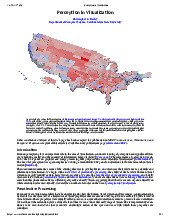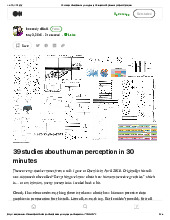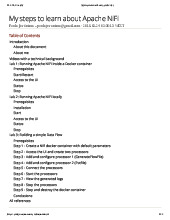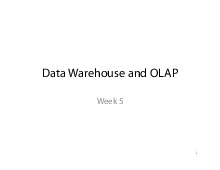


Preview text:
See discussions, stats, and author profiles for this publication at: https://www.researchgate.net/publication/277587262
Text Visualization Browser: A Visual Survey of Text Visualization Techniques
Conference Paper · November 2014 CITATIONS READS 22 1,818 2 authors: Kostiantyn Kucher Andreas Kerren Linnaeus University Linköping University
35 PUBLICATIONS 412 CITATIONS
209 PUBLICATIONS 2,312 CITATIONS SEE PROFILE SEE PROFILE
Some of the authors of this publication are also working on these related projects: StaViCTA View project
Doctoral project: Visual analytics for explainable and trustworthy machine learning View project
All content following this page was uploaded by Andreas Kerren on 02 June 2015.
The user has requested enhancement of the downloaded file.
Text Visualization Browser:
A Visual Survey of Text Visualization Techniques Kostiantyn Kucher⇤ Andreas Kerren†
ISOVIS Group, Department of Computer Science, Linnaeus University, V¨axj¨o, Sweden
Figure 1: The web-based user interface of our visual survey. By using the interaction panel on the left hand side, researchers can look for specific
visualization techniques and filter out entries with respect to a set of categories (cf. the taxonomy given in Sect. 2). Details for a selected entry
are shown by clicking on a thumbnail image in the main view. The survey contains 100 categorized visualization techniques by June 24, 2014. ABSTRACT
why we have decided to construct a taxonomy with numerous cat-
Text visualization has become a growing and increasingly impor-
egories and subcategories that is exploited by the survey browser
tant subfield of information visualization. Thus, it is getting harder
in order to facilitate the interactive exploration of the current set of
for researchers to look for related work with specific tasks or visual
entries. Our visual survey has been implemented as an interactive
metaphors in mind. In this poster, we present an interactive visual
web page and includes 100 techniques at present originating from
survey of text visualization techniques that can be used for the pur-
peer-reviewed work in InfoVis, Visual Analytics and other relevant
poses of search for related work, introduction to the subfield and
research fields. After a short discussion on relevant surveys in the
gaining insight into research trends.
following, we highlight the taxonomy used by our survey browser
as well as some implementation details.
Keywords: Visualization, text visualization, survey, interaction, web-based systems
Related Surveys There are a number of survey papers in the
literature that focus on text visualization or its specific subprob- 1 INTRODUCTION
lems. ˇSili´c and Baˇsi´c [5] classify text visualization methods with
The interest for text visualization and visual text analytics has been
regard to data source, underlying text representation and processing
increasing for the last ten years. The reasons for this develop-
method, temporal aspects, and supported user interactions. Alen-
ment are manifold, but for sure the availability of large amounts
car et al. [1] describe techniques by means of data source, under-
of heterogeneous text data (caused by the popularity of online so-
lying text representation, visual metaphor, layout, and supported
cial media) and the adoption of text processing algorithms (e.g., for
user tasks. Gan et al. [2] categorize techniques on the basis of data
topic modeling) by the InfoVis and Visual Analytics communities
source, user tasks, visual representation, and supported interactions.
are two possible explanations. Inspired by the TreeVis.net [3] and
The recent work of Wanner et al. [6] on event detection in texts
TimeVis [4] projects, we propose an interactive visual survey of text
classifies visualization approaches with regard to data source, text
visualization techniques that can be used for getting an overview of
processing methods, event detection methods, visualization repre-
the field, teaching purposes, and finding related work based on vari- sentations, and tasks.
ous categories defined in a survey taxonomy. Our web-based survey
Finally, the aforementioned visual survey projects use dimen- browser is available at:
sionality, visualization metaphor and alignment to classify tree-
oriented techniques [3], and data properties, temporal properties, http://textvis.lnu.se/
visual representation (dimensionality and animation support) to
The term ’text visualization’ is typically used for information visu-
classify time-oriented techniques [4].
alization techniques which in some cases focus on raw textual data,
in other cases on results of text mining algorithms. In the same 2 SURVEY TAXONOMY
way, they can be rather general or very specialized and dedicated
to specific analytic tasks or application domains. This is the reason
We have arranged a taxonomy (cf. Fig. 2) with multiple categories
in order to classify the techniques with fine granularity. While we
⇤e-mail: kostiantyn.kucher@lnu.se
cannot claim that our classification is absolutely definite (numerous
†e-mail: andreas.kerren@lnu.se
techniques have been ambiguous, especially in case of hybrid ap-
proaches), we have tried to base the choice of categories for partic-
ular entries on the description and claims of the original author(s).
Poster Abstract, IEEE Information Visualization (InfoVis '14), Paris,
For example, certain techniques could be easily applied to domains France, 2014.
other than originally described, but we do not reflect that in our
Figure 2: The taxonomy of text visualization techniques used in our visual survey.
choice of categories for those techniques. On the other hand, some
papers mentioned specific domains only for the sake of giving ex-
amples, though the corresponding techniques were not tailored for
those domains. In such cases, we have not assigned entries to those
domain categories. Our top-level categories include the following:
Analytic Tasks This category describes high-level analytic tasks
that are facilitated by corresponding techniques: these items
Figure 3: Details of a survey entry.
are critical to the main analysis goals that users expect to
achieve when employing a visualization technique.
we use simple bar charts for showing the statistics. The results in-
Visualization Tasks This category describes lower-level represen-
dicate that currently all entries are assigned with category tags per-
tation and interaction tasks that are supported by the tech-
taining to visualization tasks, data source, visual dimensionality,
niques, for instance, clustering or the identification of a region
and representation; 95 entries are relevant to specific analytic tasks, of interest.
and 74 are relevant to particular data domains.
Domain This category describes the dedicated text domains a tech- nique was developed for. 4 CONCLUSION
Data This category comprises two subcategories, Source and
In this poster abstract, we presented a visual survey of text
Properties, that describe the type of data source and—if
visualization techniques. The main contributions of this work
available—special properties (e.g., time-series) of data used
are the survey taxonomy and the interactive web-based browser
by the corresponding techniques.
that currently includes 100 techniques. In the future, we plan to
Visualization This category consists of three subcategories: Di-
continue including new entries and create additional visualizations
mensionality, Representation, and Alignment (i.e., the layout).
based on the data the entries provide.
By using them, we can describe the corresponding properties
Acknowledgements The authors wish to thank Hans-J¨org Schulz
of visual representations used by the techniques.
and Christian Tominski from the University of Rostock, Germany,
for the inspiration and access to their source codes as well as their 3 INTERACTIVE BROWSER
valuable comments and input. This work was partly funded by the
We have implemented our visual survey as an interactive
framework grant “The Digitized Society – Past, Present, and Fu-
HTML/JavaScript page that merely requires a modern web browser
ture” with No. 2012-5659 from the Swedish Research Council.
for access, see Fig. 1 for a screenshot. The survey browser has a
main view with a collection of thumbnails (ordered by time) that REFERENCES
represent the individual visualization techniques as well as filter
[1] A. B. Alencar, M. C. F. de Oliveira, and F. V. Paulovich. Seeing Beyond
controls that comprise text search field and category radio buttons.
Reading: A Survey on Visual Text Analytics. Wiley Interdisciplinary
Our interface does not provide dedicated controls for selecting
Reviews: Data Mining and Knowledge Discovery, 2(6):476–492, 2012.
a time range, but the publication year is available for every tech-
[2] Q. Gan, M. Zhu, M. Li, T. Liang, Y. Cao, and B. Zhou. Document Vi-
nique reference. So, it is possible to use the text search field to
sualization: An Overview of Current Research. Wiley Interdisciplinary
filter entries for a specific year. After clicking on an entry’s thumb-
Reviews: Computational Statistics, 6(1):19–36, 2014.
nail image, the corresponding details are displayed in a dialog box.
[3] H.-J. Schulz. TreeVis.net: A Tree Visualization Reference. Computer
Here, a slightly larger thumbnail, a complete list of assigned cate-
Graphics and Applications, IEEE, 31(6):11–15, Nov 2011.
gory tags, a bibliographical reference, a URL (optional), and a link
[4] C. Tominski and W. Aigner. The TimeVis Browser. Available at http:
to a BibTeX file (if available) are displayed (see Fig. 3).
//survey.timeviz.net/. Accessed: 2014-06-18.
[5] A. ˇSili´c and B. D. Baˇsi´c. Visualization of Text Streams: A Survey.
We have also provided an additional form for authors who wish
In R. Setchi, I. Jordanov, R. Howlett, and L. Jain, editors, Knowledge-
to add a new entry to our survey. The form generates a JSON entry
Based and Intelligent Information and Engineering Systems, volume
that can be sent to us via email to prevent direct-manipulation of
6277 of Lecture Notes in Computer Science, pages 31–43. Springer
the survey browser content. Finally, we visualize some basic statis- Berlin Heidelberg, 2010.
tics about the current entry set in the “About” dialog. Since the
[6] F. Wanner, A. Stoffel, D. J¨ackle, B. C. Kwon, A. Weiler, and D. A.
techniques can be assigned with multiple category tags, the sets of
Keim. State-of-the-Art Report of Visual Analysis for Event Detection
corresponding techniques overlap for sibling categories—therefore,
in Text Data Streams. Computer Graphics Forum, 33(3), 2014. View publication stats



